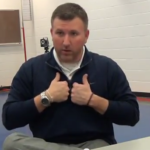News & Views
Heavy Backpacks Causing Pain in Small Children

Dr. John C. Garner demonstrates where the shoulder straps should rest when a child wears a backpack properly. Photo by Greg Kennedy
By Greg Kennedy, Ole Miss education major, gjkenned@go.olemiss.edu
Today’s students are carrying backpacks loaded with 10 to 20 percent of their body weight; as a result there is serious potential for physical damage to their lower backs.
Noah Franks is now a 7th grade student at Oxford Middle School. He’s struggled with overweight and bulging backpacks for years.
“In 6th grade it was really heavy because I had to go up the stairs all day long, it was not the best year I’ve had,” said Noah.
Eventually, Noah said the weight started to take a physical toll on his body.
“Every single day my shoulders hurt so bad, that I just literally about have to start crawling on the second flight of steps because it is so heavy.”
According to researchers, kids like Noah are putting themselves at risk for back problems as grown-ups. One study, conducted by researchers at the University of Miami, found that carrying heavy backpacks is a risk factor for musculoskeletal disorders. “A history of back pain in childhood is the strongest predictor of having back pain and musculoskeletal discomfort in adulthood,” noted the research.
And the problem is widespread. According to research published in “The Spine Journal,” 37 percent of children aged 11 to 14 say they have back pain, and most say it’s caused by their school backpacks.
Noah’s father, Chad Franks, is an eighth grade teacher in Oxford and knows that kids often carry too much in their backpacks.
“On average I hear kids talk about their backpacks weighing between 17 and 20 pounds, and when average bodyweight is between 120 and 130, you’re talking about well over 10 percent of their body weight,” said Chad.
He says he’s taken steps to protect his son’s back from such heavy loads.
“As a parent, it concerns me to the point that I have talked to his teachers, and I told them to do whatever they want for his grades or whatever, but we are going to do what we think is best in terms of the amount of material he carries on a daily basis.”
Limiting the amount of weight a child carries is just one approach to this problem. According to Dr. John C. Garner III, Ph.D., director of the biomechanics laboratory at the University of Mississippi, there’s another concern.
“I would say the biggest issue is not necessarily the heavy backpacks, but the improper wear of that load which is causing some of the spine issues,” said Dr. Garner.
He says there’s a right way to carry a heavy load.
“The backpacks are designed to be carried high on the back. The best example is if you look at a fireman, they are carrying 50 or 60 pounds, another example is a military person because of the ruck packs they are wearing. They carry them high on their back,” said Garner.
Some parents have chosen to opt for rolling backpacks to help alleviate the problem, while others hope that technology will one day provide the solution.
“I think the greatest opportunity would be laptops, some type of digital media even if it does not go home with the kids, if it’s by class, whatever would be necessary for the kids to use. We could go as paperless as possible with that way,” Chad said.
Until then, parents can educate themselves by visiting the American Occupational Therapy Association (AOTA) website. This section of the website is dedicated to supplying students, parents, teachers and school administrators with the knowledge and safety tips needed to stay protected from back pain.
























